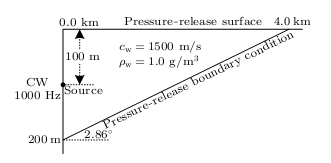Modeling sound propagation in range-dependent ocean waveguides is of particular interest to the underwater acoustics community. A number of approaches have been developed for solving such problems over the past several decades, for example, the parabolic equation method, the normal mode method, the wave-number spectrum method, the finite element method, and so on. Among them, the coupled normal mode method is very important because of its high accuracy.
Continuous variations of the coupled-mode system have been developed by many researchers. Recently, a stepwise coupled-mode method with the use of the direct global matrix (DGM) approach was derived by LUO Wenyu from the Institute of Acoustics, Chinese Academy of Sciences and several other researchers. Herein, the DGM approach can be applied to modeling of range-dependent sound propagation to achieve numerically stable and accurate solutions. And this method is capable of handling two-dimensional problems with either a point source in cylindrical geometry or a line source in plane geometry.
In this research, it first briefly introduces the stepwise coupled-mode method with the use of the DGM approach. Second, an efficient and memory-saving algorithm is provided for solving the linear system. Wherein, the global coefficient matrix is treated as a block pentadiagonal matrix including some zero elements of diagonal submatrices. As a result, this numerical model has the ability to solve large-scale problems on regular computers. Third, this model is applied to solve an ideal wedge problem (Fig. 1). As well, the result is compared with the analytical solution to demonstrate the accuracy and efficiency of this method.

Fig. 1. Geometry of the ideal wedge problem (Image by QIN)
This research is supported by the National Natural Science Foundation of China under Grant Nos 11125420 and 11104312, and the Knowledge Innovation Project of the Chinese Academy of Sciences.
The research with the title of “Numerical Solution of Range-Dependent Acoustic Propagation” was released online: http://iopscience.iop.org/0256-307X/30/7/074301 and on the journal of Chinese Physics Letters (Vol.30, No.7, July 2013).
Correspondence author:
QIN Jixing
State Key Laboratory of Acoustics, Institute of Acoustics, Chinese Academy of Sciences, Beijing 100190
Email: qjx@mail.ioa.ac.cn


